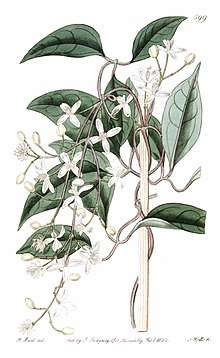Clematis hedysarifolia
Clematis hedysarifolia is a liana, endemic to peninsular India, belonging to the buttercup family (Ranunculaceae). It was described by Augustin Pyramus de Candolle and published in Regni Vegetabilis Systema Naturale 1: 148, in 1817.[1]
| Clematis hedysarifolia | |
|---|---|
 | |
| Scientific classification | |
| Kingdom: | Plantae |
| Clade: | Tracheophytes |
| Clade: | Angiosperms |
| Clade: | Eudicots |
| Order: | Ranunculales |
| Family: | Ranunculaceae |
| Genus: | Clematis |
| Species: | C. hedysarifolia |
| Binomial name | |
| Clematis hedysarifolia | |
Description
It is a woody evergreen climber, with the following features:[2][3][4]
- Branches - ribbed, roundish, thinly sprinkled with very fine soft hairs when young.
- Leaves - pinnate or bipinnate, opposite, in pairs alternately perpendicular, with wide intervals between the pairs, with 3 leaflets.
- Petiole : purplish, slightly hairy, up to 9 cm long, sometimes twining.
- Leaflets : leathery, green, glabrous, stalked, entire, ovate lanceolate, with acuminate apex, base rounded or cordate, strongly reticulate, .
- Inflorescence - Flower panicles are arise in leaf axils and at the end of branches, pendulous, many-flowered, branchlets stiff, decussately opposite and wide apart. Flower stalks are slender, hairy, bearing two small opposite abortive buds below their middle. Flowers are white, furred on the outside, about 1.6 cm across.
- Flowers - yellowish-green to white, furred on the outside, about 1.6 cm across.
- Sepals - 4, ovate, ovate-oblong, externally tomentose
- Petals - 4, ovally oblong, equal, blunt, cruciately rotate.
- Stamens - cream-coloured, upright, about 1/4 shorter than the petals, many, smooth.
- Anthers - Compressed, threadlike filaments. Anthers of same color, linearly oblong, upright with a short obtuse point and a flattish receptacle.
- Pistils - longer than the stamens, greenish.
- Fruit/Seeds - Achenes compressed, broadly elliptic or ovate, hairy, 5mm × 3mm.
Easily distinguished from the common Clematis gouriana, by the larger flowers and aristate (pointed) anthers.[2]
_(5155235250).jpg) Flower
Flower.jpg) Flower pannicle
Flower pannicle.jpg) Tendrils, leaf stalk with buds
Tendrils, leaf stalk with buds
Distribution
The species is endemic to India, and found in forests of Gujarat, Maharashtra, Goa, and Karnataka states.[5] The creeper occurs in moist deciduous forests between the altitudes of 500–1500 m.[4][5] Flowering is October–November, and fruiting is in December.[2]
gollark: I'm running an instance of nimforum for reasons, is there a way to embed external images?
gollark: And OSes have rather a lot of sources of unpredictable data which is aggregated into "random" values.
gollark: CPUs have onboard random number generators using thermal noise or something now.
gollark: Does anyone know how to give SQL queries array parameters in `tiny_sqlite`? SQLite has a CARRAY thing but it's not builtin and `tiny_sqlite` doesn't mention any support for it. Are there other libraries which can do this? I think I can use the JSON extension for this but ew.
gollark: Doing it yourself would probably be vulnerable to horrible side channel attacks.
References
- "Clematis hedysarifolia DC". The Plant List. Retrieved 16 March 2018.
- W A Talbot (1902). The Trees, Shrubs and Wood-Climbers of the Bombay Presidency (2 ed.). Bombay: Government Central Press.
- "Burman Clematis". Flowers of India. Retrieved 17 March 2018.
- Sardesai, Milind; Govekar, Ravikiran; Yadav, SR (2013). Field Guide to the Plants of Sahyadri and Konkan. Pune: Forest Department, Government of Maharashtra. p. 138.
- Wang Wen-Tsai (2006). "A revision of Clematis sect. Naraveliopsis (Ranunculaceae)" (PDF). Acta Phytotaxonomica Sinica. Botanical Society of China and the Institute of Botany, Chinese Academy of Sciences. 44 (6): 670–699. doi:10.1360/aps050090. Retrieved 16 March 2018.
External links
| Wikispecies has information related to Clematis hedysarifolia |

This article is issued from Wikipedia. The text is licensed under Creative Commons - Attribution - Sharealike. Additional terms may apply for the media files.